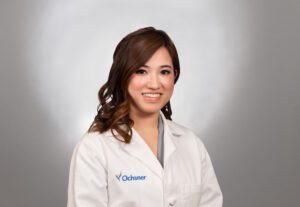Disclosure :: This post is sponsored by Ochsner Health and written by Dr. Jessica Chu.
How to Start a 3-Step New Year Skin Routine
 Healthy skin is beautiful skin. We sometimes forget that the skin is the largest organ of the human body, and this organ at times deserves extra TLC! Our skin protects us from the world we’re exposed to every day and can serve as a window into our internal medical conditions. An everyday skincare routine doesn’t have to be complicated—in fact, the simpler the routine, the more likely we are to keep it! A basic skincare routine should include a cleanser, moisturizer, and sunscreen.
Healthy skin is beautiful skin. We sometimes forget that the skin is the largest organ of the human body, and this organ at times deserves extra TLC! Our skin protects us from the world we’re exposed to every day and can serve as a window into our internal medical conditions. An everyday skincare routine doesn’t have to be complicated—in fact, the simpler the routine, the more likely we are to keep it! A basic skincare routine should include a cleanser, moisturizer, and sunscreen.
Morning:
- Use a gentle cleanser to thoroughly wash your face, ears, and neck with a soft face cloth. If your skin is on the drier end, you can consider skipping this step if your nighttime routine involves a thorough cleansing to remove excess oil, dirt, makeup, and dead skin cells.
- Apply an unscented moisturizer, which will keep your skin smooth and soft. A moisturizer also keeps your skin healthy so that it can continue to protect you. If you have oily skin, consider a lighter formula. If you have dry skin, you may need a thicker, heavier formula.
- Use sunscreen. Apply SPF 30 or higher, and don’t forget your ears, neck, and chest when you apply sunscreen. Sunscreen is important for everyone to wear regardless of age or skin color. Not only are you limiting your risks of developing skin cancers, but you can also slow down your skin’s aging process. Sunscreen technology has improved a lot over the years and doesn’t have to leave a white cast, be sticky, or oily. With a bit of quick research, you can find one that works for daily use. Don’t forget to reapply if you get wet, sweaty or if you’re spending more than two hours in the sun.
At night, repeat the same routine, but you can leave sunscreen out. Depending on your skin type, you may want to use a lighter moisturizer.
A few more pointers to keep in mind:
- Perform self-checks on your skin every six months and note any changes.
- Visit with a dermatologist at least once per year. Along with discussing your skincare routine, your dermatologist can document significant moles on your body. When you return for your next appointment, they will be able to detect any differences and move forward with a treatment plan.
- Start using anti-aging products while your skin is still in its prime. As we age, our skin’s cells turn over less rapidly, which causes our skin to appear dull. Whatever your current age, this is the perfect time to incorporate anti-aging products into your routine (once you get the basics down, of course).
- Consider a retinoid. Retinoids trigger collagen and elastin production, which help support the structure of the skin, thereby decreasing the appearance of fine lines, improving discoloration, and brightening up your skin. Retinoids come in many forms. There are over-the-counter options, such as ones from ROC or CeraVe. If you are looking for more potent forms of retinoids, your dermatologist can prescribe the most fitting for your skin type.
- Before you jump into your skincare routine, wash your hands. Bacteria, dirt, and oils accumulate on your hands. It’s a good idea to wash your hands for 20 seconds with soap and warm water before touching your face.
- Use a warm face cloth on your skin to help open your pores. Open pores absorb products better, and warm water will help them open.
- Get enough sleep! If you’re not getting enough sleep, it won’t matter how great your skincare routine is. Skin is important for overall health, and there’s some truth to the idea of “beauty sleep.” For adults aged 18-65, the Centers for Disease Control recommends at least seven hours of sleep.
- Drink plenty of water. Moisturizing isn’t just for your skin. Staying hydrated will have positive effects on your skin.
Learn more about Dr. Jessica Chu. Make a Dermatology appointment with Ochsner Health.
Make a Dermatology appointment with Ochsner Health.



















